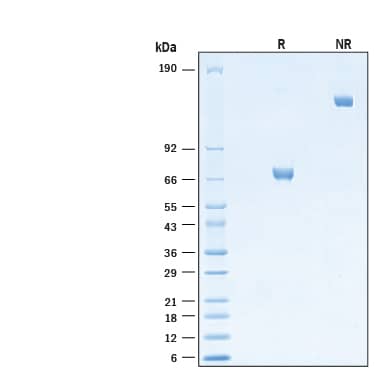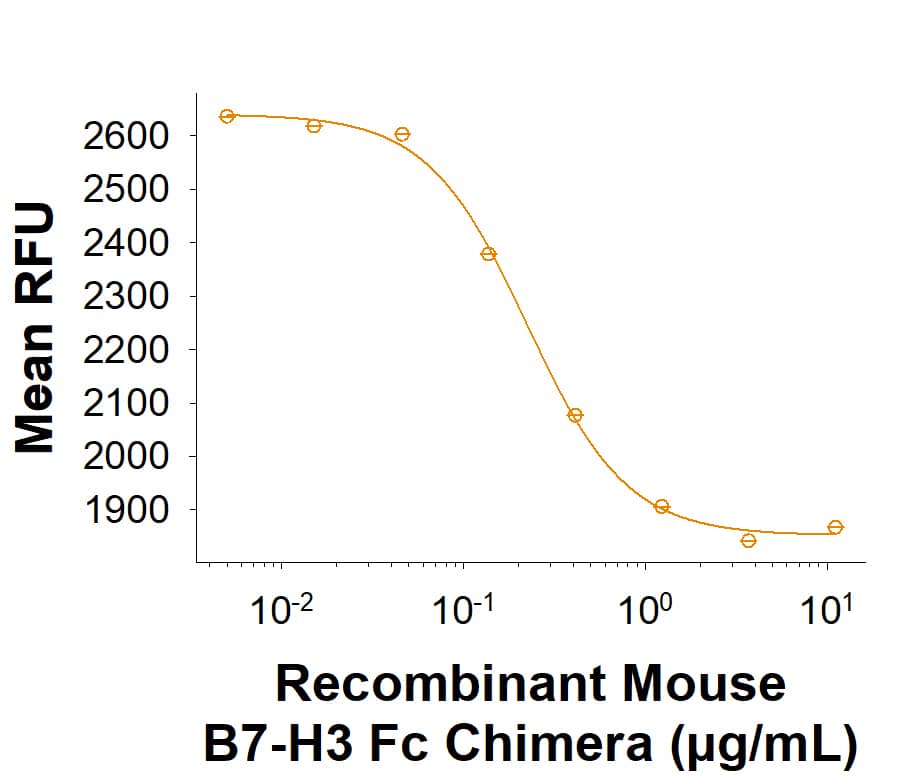Recombinant Mouse B7-H3 Fc Chimera Protein, CF
R&D Systems, part of Bio-Techne | Catalog # 10946-B3

Key Product Details
Source
Accession #
Structure / Form
Conjugate
Applications
Product Specifications
Source
| Mouse B7-H3 (Val29-Phe244) Accession # Q8VE98.1 |
IEGRMD | Human IgG1 (Pro100-Lys330) |
| N-terminus | C-terminus |
Purity
Endotoxin Level
N-terminal Sequence Analysis
Predicted Molecular Mass
SDS-PAGE
Activity
Measured by its ability to inhibit Mouse CD3 epsilon Antibody induced proliferation of Mouse T cells. The ED50 for this effect is 0.06-0.72 µg/mL.
Scientific Data Images for Recombinant Mouse B7-H3 Fc Chimera Protein, CF
Recombinant Mouse B7‑H3 Fc Chimera Protein Bioactivity.
Recombinant Mouse B7-H3 Fc Chimera (Catalog # 10946-B3) inhibits Mouse CD3 epsilon Antibody (Clone # 145-2C11, MAB484) induced proliferation of Mouse T cells. The ED50 for this effect is 0.06-0.72 µg/mL.Recombinant Mouse B7‑H3 Fc Chimera Protein SDS-PAGE.
2 μg/lane of Recombinant Mouse B7‑H3 Fc Chimera Protein (Catalog # 10946-B3) was resolved with SDS-PAGE under reducing (R) and non-reducing (NR) conditions and visualized by Coomassie® Blue staining, showing bands at 65-73 kDa and 130-150 kDa, respectively.Formulation, Preparation and Storage
10946-B3
| Formulation | Lyophilized from a 0.2 μm filtered solution in PBS with Trehalose. |
| Reconstitution | Reconstitute at 500 μg/mL in PBS. |
| Shipping | The product is shipped at ambient temperature. Upon receipt, store it immediately at the temperature recommended below. |
| Stability & Storage | Use a manual defrost freezer and avoid repeated freeze-thaw cycles.
|
Background: B7-H3
T cells require a signal induced by the engagement of the T cell receptor and a “costimulatory” signal(s) through distinct T cell surface molecules for optimal T cell expansion and activation. Members of the B7 superfamily of counter-receptors were identified by their ability to interact with costimulatory molecules found on the surface of T cells. Members of the B7 superfamily include B7-1 (CD80), B7-2 (CD86), B7-H1 (PD-L1), B7-H2 (B7RP-1), B7-H3, and PD-L2 (1). B7-H3 is expressed at very high levels in immature dendritic cells at moderate levels on mature dendritic cells, LPS stimulated immature dendritic cells and LPS stimulated monocytes, and at low levels on resting monocytes. B7-H3 binds to activated T cells via an as-of-yet identified receptor. B7-H3 co-stimulates proliferation of T cells and interferon-gamma (IFN-gamma) production and enhances the induction of cytotoxic T cells. B7-H3 shares 20 - 27% amino acid (aa) identity with other B7 family members (2). Murine B7-H3 is a 259 aa protein containing an extracellular domain, a transmembrane domain and a cytoplasmic domain. Mouse and human B7-H3 share 87% aa identity (3).
References
- Coyle, A.J. and J.-C. Gutierrez-Ramos (2001) Nature Immunol. 2:203.
- Chapoval, A.I. et al. (2001) Nature Immunol. 2:269.
- Sun, M. et al. (2002) J. Immunol. 168:6294.
Long Name
Alternate Names
Gene Symbol
UniProt
Additional B7-H3 Products
Product Documents for Recombinant Mouse B7-H3 Fc Chimera Protein, CF
Product Specific Notices for Recombinant Mouse B7-H3 Fc Chimera Protein, CF
For research use only

